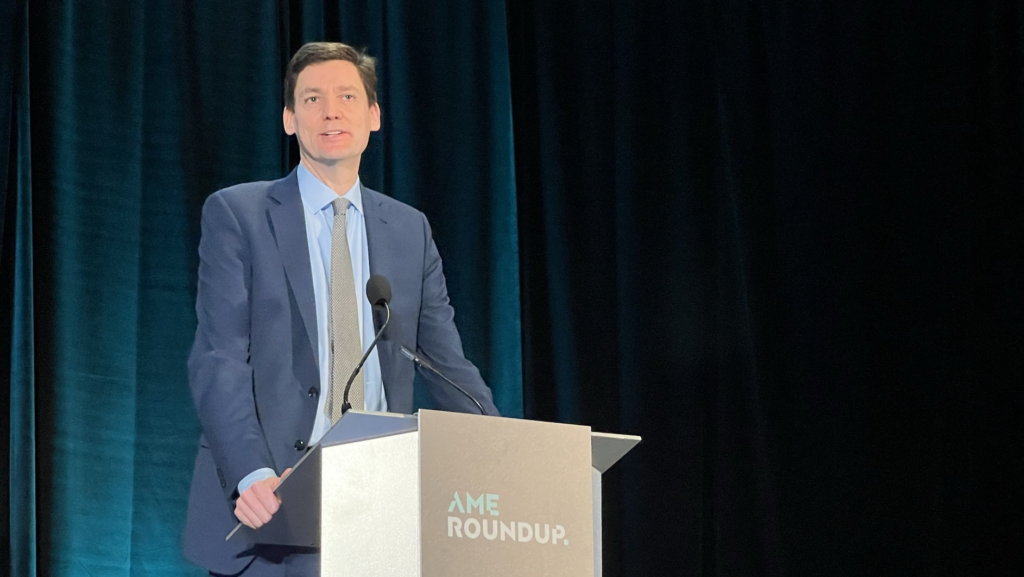British Columbia is a major feature of Canada’s mining landscape, as demonstrated by the record-setting $740.4 million (US$552.8 million) spent there by mineral explorers in 2022, Premier David Eby told last week’s AME Roundup conference in Vancouver.
Almost 6,000 geoscientists, prospectors, financiers, investors, Indigenous partners, suppliers, and government representatives from 39 countries gathered for the event.
The previous spending record was set a decade ago at $681 million, and 2021 saw $660 million in exploration spending. The rise was underpinned by an 84% increase in copper exploration budgets, Eby said, with the province’s ‘Golden Triangle’ in the northwest receiving most of the attention.
In all, there are eight new mines or mine expansions in the pipeline in B.C. worth a total of $6.6 billion.

B.C. Premier David Eby at AME Roundup in Vancouver in January. Henry Lazenby photo
The most advanced project is Ascot Resources’ (TSX:AOT) Premier Gold mine, located in the province’s northwest on Nisga’a Nation treaty land. Ascot raised $200 million to finance its construction, now underway.
The Nisg̱a’a Nation and the Tahltan Nation announced last Thursday that they have formed a new partnership that will optimize nations’ participation in the massive Seabridge KSM project, currently the third largest ranked copper project in the world, with nearly 25 million tonnes of copper in reserves.
In response to questions sent to the premier’s office, Eby’s spokesperson Timothy Chu outlined the province’s plans for the permitting process.
MDC: What role does the premier see the province playing in Canada’s push to become a bigger supplier of critical minerals?
PO: B.C. has a deep history in mining and exploration, and mining and exploration continues to be a foundation of the province’s economy. B.C. has the potential to further grow the sector to provide more of the critical minerals and metals needed for the growth of emerging technologies, such as electric cars and wind turbines that the world will need to fight climate change.
The province is committed to developing a strategy that aligns with the federal strategy while advancing B.C. priorities that will build on foundational geoscience work.
MDC: Can you expand on comments about intending to bring the same ‘one-stop approach’ to processing natural resource projects permits as the Housing/Forestry strategy?
PO: While housing has been prioritized in the adoption of the ‘one-stop approach,’ permitting solutions for natural resource developments across the sector are also priorities.
We are working towards legislation and policy shifts, systems changes and more supports for statutory decision makers, such as additional resources and training. Best practices are achieved through the single window approach we’ve rolled out for housing-related authorizations [and] are expected to be scalable and broadly applicable across the entire natural resources sector.
It’s important to keep in mind that housing is a requirement for industries to attract the skilled workforce they need. Accelerating our provincial efforts on housing helps industry.
Also, as the premier stated in his speech, many of the same people working on housing applications at the Ministry of Environment, for example, are also the ones tasked with assessments for new mines. With a “one-stop shop approach” for housing and additional staff, it will ease the pressure on a clogged system.
MDC: How many staff will be allocated to address the backlog in mining?
PO: The province has taken significant steps to ensure the process of permitting is efficient. We have dedicated $18 million over three years to support permitting and Environmental Assessment reviews, including funding 13 new regional permitting positions. We know we have more work to do, and that a smooth environmental assessment process with our federal counterparts is crucial.
MDC: Do you plan to engage more with First Nations governments to bring them on board with resource projects?
PO: We all want our natural resources sector to support reconciliation with Indigenous Peoples, environmental sustainability, and economic benefits.
One of the priorities for the Ministry of Water, Land and Resource Stewardship is to create a new vision for land and resource management with First Nations that will help us make decisions together about how we use the land to benefit all British Columbians.
There are several areas around the province where we are working in close collaboration with First Nations to improve stewardship through the Collaborative Indigenous Stewardship Forums and through Modernized Land Use Planning.
Collaborative Indigenous Stewardship Forums are a partnership with First Nations to build trusted data that can be used to improve management and planning for water, land and natural resources.
Modernized land use plans increase predictability and clarity on the land base for economic opportunities, ensure protection of environmental and cultural values, and provide direction related to changing socio-economic conditions and climate change considerations.


Be the first to comment on "Solutions for mining permits ‘a priority’, says B.C. premier"